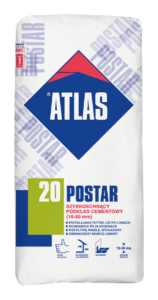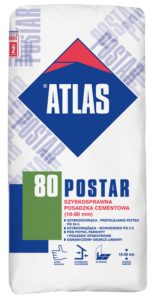- Products
- Systems
- Tools & Services
News
Floors and screeds – defects under investigation
Use of ready-made mortars helped to eliminate many errors which used to be common during independent preparation of flooring mortars by contractors. Unfortunately, ready-made mortars brought other problems. Let’s mention here for example their great diversity. It may lead to errors as the contractors sometimes do not apply to the specific guidelines indicated by the manufacturer. It is observed that among these uncompiled recommendations one may find: mortar to water ratio, layer thickness and execution of expansion joints.
Case 1. Lack of expansion joints (Photo 1, 2)
Defect
Cement screed made of ready-to-use cement mortar was installed in a garage approx. 60 m² large. Before the epoxy floor was laid upon it, the investor noticed scratches of a very regular shape on the screed surface. The scratches formed regular pattern of identical squares – they formed spontaneously and in uncontrolled manner. In this situation it was not necessary to report any complaints. The conversation between the investor, who was left alone with the scratches as the contractor left the site, and our technical advisor was enough to establish the cause of the defect.
Diagnosis
It was the lack of control expansion joints which led to the scratches formation. The most important limitation in the application of cement screeds is the shrinkage which entails reduction of the size of areas covered in a single application cycle. To avoid the shrinkage effects one needs to apply control expansion joints. The width of the expansion joint depends mostly on the room area and should vary between 4 and 12 mm. The joint should be filled with material which enables movement and deformation of screed resulting from shrinkage.
Solution
The main purpose of control expansion joints is to eliminate stress and accidental cracks resulting from shrinkage
during drying or temperature and/or moisture content change. They should enable horizontal movement and prevent from vertical movement. They are usually applied in still fresh screed as a score of depth between 1/3 to 1/2 of the screed thickness.
Self-caused crack under the scores engages two adjacent areas and prevents them from curling.
Control expansion joints should divide the screed area into smaller areas of shape similar to a square. If it is difficult to form them, one should aim to obtain the area of sides ratio not greater than 2:1. Expansion joints are also placed in points, where the shape of the room changes, e.g. at thresholds and at joints between two materials of different structure. It is recommended not to exceed the area of 36 m2and the side length of 6 m in case of cement screeds applied indoors. In case of screeds based on sulphate calcium (e.g. anhydrite), their area should not exceed 50 m2, while the length of the side should be shorter than 10 m.
The size of the areas located outdoors should be smaller than 5 m2 (the maximum length of the side is 3 m).
Case 2. Extensive shrinkage (Photo. 3)
Defect
Investor reported that cracks appeared on screed which has just been applied. This time, the shrinkage cracks were not as regular as in the first reported case.
Diagnosis
It is difficult to indicate unambiguously the cause of the defect in such cases. Therefore, one needs to examine the used material first. An unused bag full of mortar was handed over for testing. The study consisted of applying the screed using the remaining mortar according to all manufacturer’s recommendations. After drying, the surface of the screed was smooth and even. In result one could exclude a defect of the dry mortar.
There are three main causes for this type of cracks: too thick screed layer, contractor’s failure to abide by the mixing ratio or too fast water evaporation from the drying mortar. The first potential cause has not occurred as it was
proved by the executed outcrop. The second cause is impossible to be proved, even though the contractor said that he added “as much water as he needed to make the application easy”, when he was asked about mixing ratio of dry mortar to water. Most probably he added too much water. Finally, the third situation took place in our case – the screed was not properly protected against drying too fast.
Solution
Improper amount of batched water (excessive or insufficient) interferes with the hydration process, leading not only to cracks formation, but also to much worse strength parameters of the set mortar than expected. Lack of surface priming and maintenance after application (sprinkling the screed with water during the initial drying and setting time when rapid strength build-up takes place) may result in rapid water draining and evaporation, especially on hot days. Whereas all the water should take part in the process of cement binding.
Case 3. Unsuitable substrate (Photo. 4)
Defect
The investor reported that the screed cracked and peeled from the substrate.
Diagnosis
When the outcrop was done, it turned out that the screed was 1 cm thick and that it was applied directly upon OSB! It is an obvious mistake which fully explains the defect. Cement screed can be applied upon most of the substrates, but in certain conditions. For example, the thickness of the cement screed depends primarily on the adapted structural arrangement:
– bonded floor (directly bonded to the substrate) – in accordance with manufacturer’s guidelines,
– on the separation layer (not directly cbonded to the substrate, e.g. on PE foil) – in accordance with manufacturer’s guidelines, but not less than 35 mm,
– floating (not directly binded to the substrate; on the thermal or acoustic insulation layer) – according to the manufacturer’s guidelines, but of thickness not less than 35 mm above the top surface of heating elements.
Solution
Application of screeds directly upon the OSB substrate is doomed to failure. First of all, cement does not have sufficient bonding to this type of material. Secondly, batched water used for preparation of mortar destroys the OSB. What one should have done is to spread PE foil upon OSB first. Moreover, one should have also checked whether the substrate was constructed with properly thick and mounted OSB. The second major error was the screed thickness – it was definitely too thin. The technical requirement for self-bearing screeds states that the minimum thickness should be 35 mm.
|
Layer thickness varies in the range between 10 and 80 mm. Foot traffic is possible after approx. 24 hours since application, the facing can be applied after 48 hours. Due to these parameters, the material performs well in repairs of concrete surfaces, stairs, slabs or screeds. Recommended for use in residential and public access buildings (owing to high resistance to compression which is 20 MPa). Suitable for difficult substrates – performs excellent in areas vulnerable to constant moisture action. Can be applied in temperature up to 30°C. Therefore, it is suitable for forming slopes on the terraces.
|
|
FAST-SETTING CEMENT FLOOR
Layer thickness varies in the range between 10 and 80 mm. Wide range of use. Can be used as screed beneath the finishing layers like ceramic and stone tiles, PVC flooring, carpet floorings, floor panels, parquet, epoxy flooring. High cohesion and resistance to abrasion make it possible to use the material as a screed for parquet or epoxy flooring. Reaches the operational and resistance parameters in a very short time. It enables to limit significantly the technological breaks and to accelerate the start of further works. Recommended for use in residential buildings, warehouses, industrial facilities, on terraces and driveways (resistance to compression of 40 MPa and high resistance to abrasion).
|
Original text: Piotr Idzikowski, ATLAS Group
English text: Piotr Marciniak, ATLAS Group











 ATLAS POSTAR 20
ATLAS POSTAR 20 ATLAS POSTAR 80
ATLAS POSTAR 80